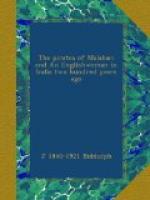“Those who are captured shall be whipped and put in the galleys for five years, and, if of noble birth, they shall pay the sum of one thousand xeraphims in lieu of working in the galleys, and shall be transported for five years to the fortress of Diu."[1]
It seemed as if Boone was to have a Portuguese war added to his other troubles. Fortunately, more moderate counsels prevailed, and, in September, a conciliatory letter was written to Boone by the Viceroy, announcing his approaching departure. A few days later, the new Viceroy, Francisco Jose de Sampaio e Castro, arrived in Goa. While the quarrel was in progress, a native ship from Surat, bound for Jeddah, was captured off Bassein by a European pirate ship. This was probably England’s ship, Victory, of which we shall hear more directly. The ship and cargo, valued at twelve lakhs, were carried off, and the passengers and crew put ashore at Malabar Hill.
A month later, Boone received intelligence of a serious loss to the Company’s trade from the Madagascar pirates. On the 7th August, the Greenwich, Captain Kirby, and the Cassandra, Captain James Macrae, bringing the usual yearly investment for Bombay and Surat, were in Johanna roads, engaged in watering. At anchor, near them, was an Ostend ship that had called for the same purpose. A few days before, they had received intelligence that a French pirate, Oliver la Bouche,[2] had run on a reef off Mayotta, and lost his ship, and was engaged in building a new one. Thinking that the opportunity of catching the pirates at a disadvantage should not be lost, Macrae and Kirby agreed to go in search of them and attack them. They had just completed their arrangements when two strange sails hove in sight. They proved to be the Victory, a French-built ship of forty-six guns, commanded by the well-known pirate, Edward England,




